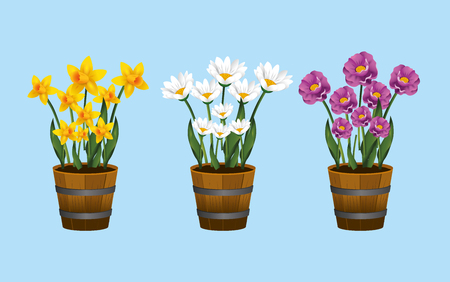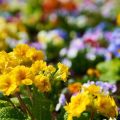1. Understanding Perennials and Their Benefits
When planning a backyard flower garden, one of the smartest choices you can make is to plant perennials. But what exactly are perennials, and why are they such a popular option for American gardeners?
What Is a Perennial?
A perennial is a plant that lives for more than two years. Unlike annuals, which complete their life cycle in one growing season, or biennials, which take two years, perennials keep coming back year after year. In most U.S. climates, they go dormant during the winter and re-emerge in the spring. This makes them both reliable and cost-effective over time.
Types of Perennials
There are many different types of perennials suited to various regions across the United States. Here’s a quick breakdown of common categories:
| Type | Description | Examples |
|---|---|---|
| Herbaceous Perennials | Die back to the ground each winter but return in spring. | Daylilies, Hostas, Coneflowers |
| Woody Perennials | Maintain above-ground structure year-round. | Lavender, Shrub Roses |
| Semi-woody Perennials | Partially die back; need pruning in spring. | Sage, Russian Sage |
Why Choose Perennials for Your Backyard Garden?
Low Maintenance
Once established, perennials require less watering, fertilizing, and overall care compared to annuals. This makes them perfect for busy homeowners who still want a beautiful yard.
Sustainability
Because they don’t need to be replanted every year, perennials reduce waste and soil disturbance. They also improve soil health over time by maintaining root systems that prevent erosion and support beneficial microbes.
Cost-Effective
You may spend more upfront on perennial plants, but they pay off in the long run by returning each year without the need to purchase new plants every spring.
Support for Pollinators
Many native U.S. perennials—like Black-eyed Susans and Milkweed—attract bees, butterflies, and other pollinators. Supporting these insects helps your whole garden thrive.
Common U.S. Hardiness Zones and Suitable Perennials
The United States Department of Agriculture (USDA) Plant Hardiness Zone Map helps determine which perennials will thrive in your area. Here are some examples:
| USDA Zone | Typical Climate | Recommended Perennials |
|---|---|---|
| Zone 3–4 (Cold) | Long winters with harsh freezes | Lupine, Peonies, Sedum |
| Zone 5–7 (Temperate) | Mild winters and warm summers | Echinacea, Coreopsis, Salvia |
| Zone 8–10 (Warm) | Mild winters with hot summers | Lantana, Gaillardia, Blanket Flower |
A Smart Start for Any Gardener
If youre just getting started with backyard gardening or looking to create a landscape that’s both beautiful and easy to maintain, perennials are a fantastic choice. With so many varieties suited to different climates across the U.S., it’s easy to find plants that will thrive in your backyard while saving you time and money season after season.
2. Choosing the Right Perennials for Your Climate
Picking the right perennials for your backyard flower garden starts with understanding your local growing conditions. From USDA hardiness zones to sunlight exposure and soil type, each factor plays a key role in helping your plants thrive year after year. Here’s how to make smart choices for a successful perennial garden.
Understand Your USDA Hardiness Zone
The USDA hardiness zone map divides the United States into zones based on average annual minimum winter temperatures. Knowing your zone helps you choose plants that can survive winter in your area.
| Zone | Temperature Range (°F) | Example Regions |
|---|---|---|
| 3-4 | -40 to -20°F | Northern Minnesota, North Dakota |
| 5-6 | -20 to 0°F | Chicago, Denver, Boston |
| 7-8 | 0 to 20°F | Atlanta, Dallas, Seattle |
| 9-10+ | 20°F and above | Southern Florida, Southern California, Phoenix |
Match Perennials to Sunlight Levels
Sunlight is just as important as temperature when choosing perennials. Check how much sun your garden gets throughout the day and match it with plant needs:
| Sunlight Level | Description | Plant Examples |
|---|---|---|
| Full Sun (6+ hrs/day) | Direct sunlight most of the day | Echinacea, Black-eyed Susan, Lavender |
| Part Sun/Part Shade (3–6 hrs/day) | Dappled light or morning sun only | Astilbe, Coral Bells, Columbine |
| Full Shade (<3 hrs/day) | Little to no direct sunlight | Hosta, Ferns, Lungwort |
Consider Soil Type and Drainage
Your soil’s texture and drainage affect how well perennials grow. Loamy soil is ideal for most plants, but some prefer sandy or clay soils. Do a simple soil test or observe how water drains after rain. If water sits too long, consider raised beds or amend the soil with compost.
Common Soil Types:
| Soil Type | Description | Best Suited Perennials |
|---|---|---|
| Sandy Soil | Drains quickly but dries out fast; low nutrients. | Yarrow, Sedum, Russian Sage |
| Clay Soil | Poor drainage; holds nutrients but can be compacted. | Iris, Daylily, Bee Balm (with improved drainage) |
| Loamy Soil | The perfect mix of sand, silt, and clay; great drainage and nutrients. | Most perennials thrive here. |
Factor in Local Weather Patterns
Beyond hardiness zones, think about your area’s specific weather quirks—like heavy rainfall, drought periods, or high humidity. For example:
- If you live in a dry region like Arizona or Nevada, go for drought-tolerant perennials such as Blanket Flower or Penstemon.
- If you deal with humid summers in the Southeast, choose disease-resistant varieties like Phlox ‘David’ or Liatris.
- If spring frosts are common where you live, avoid planting tender perennials too early in the season.
Selecting Plants That Work Together Year-Round
A good perennial garden includes plants that bloom at different times of the year. Try mixing early spring bloomers like Bleeding Heart with summer stars like Shasta Daisy and fall favorites like Asters. This way, something is always blooming in your garden from spring through frost.
A Seasonal Blooming Guide:
| Season | Blooming Perennials to Consider |
|---|---|
| Spring (Mar–May) | Tulips (technically bulbs), Bleeding Heart, Creeping Phlox |
| Summer (Jun–Aug) | Echinacea, Daylilies, Black-eyed Susan |
| Fall (Sep–Nov) | Asters, Sedum ‘Autumn Joy’, Japanese Anemone |
Selecting the right perennials based on your local climate ensures healthier plants and less maintenance over time. It also means more blooms and color across every season in your backyard flower garden!

3. Planning and Designing Your Perennial Garden
Before you start planting, its important to take time to plan and design your perennial garden. A well-thought-out layout ensures your garden looks great all year long and thrives with minimal maintenance. Heres how to create a backyard flower garden thats both beautiful and functional.
Consider Bloom Times for Year-Round Color
One of the best ways to keep your garden vibrant throughout the growing season is by mixing perennials that bloom at different times of the year. This way, theres always something flowering in your yard from spring through fall.
| Season | Example Perennials |
|---|---|
| Spring | Daffodils, Tulips, Bleeding Heart |
| Summer | Black-Eyed Susan, Coneflowers, Daylilies |
| Fall | Asters, Sedum, Japanese Anemone |
Plan by Plant Height for Visual Interest
Arrange your plants based on their mature height. Taller plants should go toward the back (or center if it’s an island bed), medium-height plants in the middle, and shorter ones up front. This helps create a layered look that lets every plant shine without being overshadowed.
Quick Height Guide:
- Tall (3+ feet): Joe-Pye Weed, Hollyhocks, Delphiniums
- Medium (1–3 feet): Coreopsis, Salvia, Shasta Daisy
- Short (<1 foot): Creeping Phlox, Lamb’s Ear, Heuchera
Create a Cohesive Color Scheme
Select a color palette that matches your personal style or complements your home’s exterior. You can go with calming cool tones like blues and purples or bold warm shades like reds and oranges. For a classic American backyard feel, try red, white, and blue combinations using perennials like red bee balm, white daisies, and blue salvia.
Color Scheme Ideas:
- Monochromatic: Shades of purple – lavender, salvia, Russian sage
- Complementary: Yellow coreopsis with purple coneflowers
- Patriotic Theme: Red bee balm, white phlox, blue delphinium
Think About Sunlight and Soil Conditions
Your gardens success depends on placing the right plant in the right spot. Observe how much sun each area gets during the day and test your soil if needed. Most perennials prefer well-drained soil and full sun (6+ hours daily), but many shade-loving varieties are available too.
Sunlight Preferences Table:
| Sun Exposure | Suggested Perennials |
|---|---|
| Full Sun (6+ hrs) | Lavender, Coneflower, Yarrow |
| Partial Shade (3–6 hrs) | Astilbe, Columbine, Foxglove |
| Full Shade (<3 hrs) | Hosta, Ferns, Lungwort |
Add Functional Elements to Your Design
A well-designed garden isn’t just pretty—it’s practical too. Include pathways for easy access to plants for watering or pruning. Use edging materials to separate beds from lawns. Consider adding a bench or small patio area so you can enjoy the view!
Functional Features to Include:
- Mulch paths or stepping stones: Prevents soil compaction and keeps shoes clean.
- Irrigation system or soaker hoses: Saves time and water.
- Borders or raised beds: Helps define space and improve drainage.
A little planning goes a long way when it comes to perennial gardening. By thinking ahead about bloom times, heights, colors, sunlight needs, and layout features, you’ll create a backyard flower garden that’s as enjoyable to maintain as it is to admire.
4. Planting and Caring for Perennials
Getting your perennials off to a great start is key to enjoying beautiful blooms year after year. Heres a simple, step-by-step guide on how to properly plant and care for perennials in your backyard flower garden.
Step-by-Step: How to Plant Perennials
- Choose the Right Time: The best times to plant perennials are in early spring or fall when temperatures are cooler and theres more natural moisture.
- Prep Your Soil: Loosen the soil about 12 inches deep and mix in compost or organic matter to improve drainage and nutrients.
- Spacing Matters: Follow the plant tag instructions for spacing. Giving plants enough room helps prevent overcrowding and disease.
- Planting Depth: Dig a hole twice as wide and just as deep as the root ball. Set the plant so the crown (where roots meet stems) is level with the soil surface.
- Backfill & Water: Fill the hole with soil, gently pat it down, then water thoroughly to eliminate air pockets around the roots.
Watering Routine
Proper watering helps establish strong roots and keeps your perennials thriving. Heres a quick reference:
| Growth Stage | Watering Frequency | Tips |
|---|---|---|
| Newly Planted | Every 2–3 days for first few weeks | Keep soil evenly moist but not soggy |
| Established Plants | Once a week (deep watering) | Water early morning or evening to reduce evaporation |
| Drought Conditions | Twice a week or as needed | Add mulch to help retain moisture |
Mulching Tips
A layer of mulch helps suppress weeds, conserve moisture, and keep roots cool during hot summers. Spread 2–3 inches of organic mulch like shredded bark or compost around your plants, but keep it an inch away from stems to prevent rot.
Fertilizing Schedule
You don’t need a lot of fertilizer to grow healthy perennials. Here’s a basic schedule:
| Time of Year | Fertilizer Type | Application Tips |
|---|---|---|
| Early Spring | Balanced slow-release (e.g., 10-10-10) | Apply around base of plants after new growth appears |
| Mid-Summer (optional) | Lighter feeding (e.g., compost tea) | If plants look tired, give them a boost with a liquid feed |
| Fall | No fertilizer needed | Avoid fertilizing late in the season—new growth can be damaged by frost |
Deadheading and Maintenance
What is Deadheading?
Deadheading means removing faded or spent flowers from your plants. This encourages more blooms and keeps your garden looking tidy.
How to Deadhead:
- Pinch or snip off flowers just above the first set of healthy leaves below the bloom.
- Avoid cutting too close to new buds that may be forming underneath.
- Certain perennials like coneflowers or black-eyed Susans can be left alone if you want seed heads for birds or winter interest.
Caring for perennials doesnt have to be complicated. With a little attention throughout the growing season, your backyard flower garden will reward you with color, texture, and beauty year after year.
5. Troubleshooting and Seasonal Maintenance
Even the most well-planned perennial gardens can face a few bumps along the way. From unexpected pests to tired soil, its important to know how to handle common issues and keep your garden looking its best through every season.
Common Perennial Garden Problems and Solutions
If your perennials arent thriving, dont worry—many problems have simple fixes. Heres a quick guide to help you identify and solve some of the most frequent issues:
| Problem | Symptoms | Solution |
|---|---|---|
| Pests (e.g., aphids, slugs, Japanese beetles) | Chewed leaves, sticky residue, or visible insects | Use insecticidal soap, hand-pick larger bugs, or introduce beneficial insects like ladybugs |
| Disease (e.g., powdery mildew, root rot) | Yellowing leaves, white powdery coating, wilting | Improve air circulation, avoid overhead watering, remove affected plant parts, and use fungicides if needed |
| Poor Soil Quality | Stunted growth, yellow leaves, poor flowering | Add compost or organic matter; consider getting a soil test and amend with necessary nutrients |
| Overcrowding | Plants competing for light and nutrients, reduced blooming | Divide perennials every few years to give them space to grow properly |
Seasonal Maintenance Tips
Spring
- Clean up any leftover debris from winter to prevent disease.
- Cut back dead stems from last year’s growth.
- Add compost or slow-release fertilizer to boost early growth.
- Divide and transplant overcrowded perennials.
Summer
- Deadhead spent blooms to encourage more flowers.
- Water deeply during dry spells—aim for early morning or late afternoon watering.
- Watch for signs of pests or disease and treat promptly.
- Add mulch to retain moisture and suppress weeds.
Fall
- Cut back perennials that have finished blooming unless they provide winter interest or food for birds.
- Add a layer of mulch or leaf litter for insulation over winter.
- Plant new perennials—fall is a great time for root development before frost sets in.
Winter
- Avoid disturbing plants; roots are dormant but still alive under the soil.
- If there’s heavy snow, gently brush it off delicate branches to prevent breakage.
- Plan next year’s garden layout and order seeds early!
Quick Checklist for Year-Round Perennial Care
| Season | Main Tasks |
|---|---|
| Spring | Tidy up beds, fertilize, divide plants, start watering routine |
| Summer | Deadhead flowers, watch for pests/disease, water regularly, mulch as needed |
| Fall | Cut back foliage, add mulch, plant new perennials if desired |
| Winter | Protect plants with mulch/snow cover, plan ahead for spring planting |
A little seasonal care goes a long way when it comes to perennial gardening. By staying on top of potential problems and adjusting your maintenance routine throughout the year, youll set your backyard flower garden up for long-term success.


